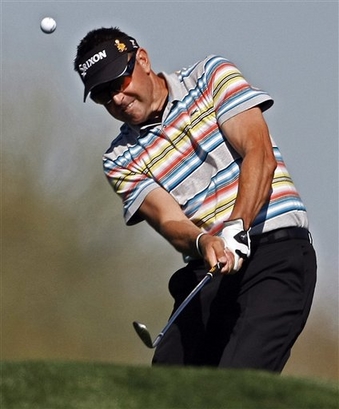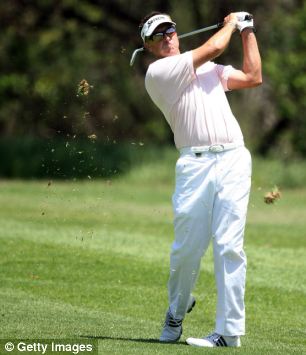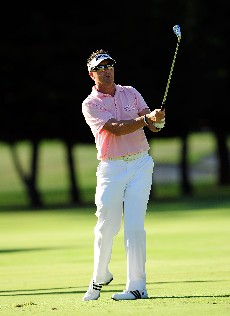That wasn’t meant to be as smart arse-ish as it sounded.
Forearm rotation is one of those terms that requires discussion imo, but Liverpool are playing Chelsea and are 1-0 up… I know we’re all rooting for Liverpool around here, right?!
What does the term mean to you?
…Btw, did any SF residents get out to see Peter Senior this week?
Macs,
Do you or anyone have pics to help visualize this?
thanks/eagle
Better yet…a video showing the “right way” and the "wrong " way. ( I know, they are options, not right and wrong necessarily)
Bom; these are my own observations so no link to Lag (althogh ABS is the sourse of the light). I will try to shoot a picture. To me its very simple.Most of us know the P3/4:30 position by now. Try to take the club there but with no Bend in the R wrist (if you can you can even bow it to make the crease in front of the R wrist more prominent). Watch out for the club wanting to rotate in your grip and avoid it. In other words you have created the 4:30 position by rotating your torso. Now if you consider it in a rally swing and achieve this position with a flat right wrist; it means having saved a lot of torso rotation or creating pivot lag or creating X-factor etc etc.
Its not a gimme yet because to create that look in a normal swing takes an enormous effort. Last night I was swinging with this intention and something bizzare happened. The grip tape failed in the mid section with grip rotating around the shaft. I grip my clubs myself so the tape is the best there is and no its not hot in here; quite the opposite.
We all usually make reference to one wrist or the other… flat left usually means bent right… and vise versa.
A flat right wrist is probably a TGMer’s worst nightmare, but if you understand that the left wrist bent produces a flattening of the right, and that both wrists should change their positioning once acceleration and force are applied to them, just as the clubshaft also will flex back, then it should start to come to light. This is dynamic movement stuff, not still shots of a vapor trail effect.
Trying to achieve a FLW void of applicable pressures from forearm rotation and or pivot acceleration have led a lot of golfers down some very bad paths. I see it all the time, and it still goes on, even in popular TGM circles… and this for me is very disappointing.
Right here, in bold, is absolutely everything (the only thing) you need to know–at least all I need to know. I have been down those bad paths–for months, years–because I wasn’t focused on making a pivot and then improving my pivot action.
Word!
Just noticed this…
I think that there is a huge amount of stuff going on at the real transition of the golf swing that speaks to maximally efficient delivery into impact together with a vicious post impact thrust…akin to a well timed uppercut that can knock you out.
I am a bit snowed under at present so have not had any time to practise or reflect on this but Lag has been posting some stuff in the module 7 forum about the ‘real transition’ not being the change in direction from the top…but instead feeling the move and change in direction of forces from p3 into impact.
This is a really great point and clarification. Ever since learning and embracing the open face idea into impact, the transition from the top, as it were, has taken on a whole new view for me. I’m waiting until I have some clearer thoughts on it before posting about it, but the main gist of it is that if we’re using rotational force in the swing, are we ever not rotating? I’m not sure on your guys view on that, but if we’re not then we’re essentially always rotating one way or the other with different parts of the body and the club. This idea can really create a lot of pressurized, contained force that wants to go. The ‘real transition’ idea hits home to me with some of the things I’ve been finding with this stuff.
Here’s another view of Allenby with totally different looking intentions

It’s always hard to tell definitively from photos, but he does appear to be hitting some sort of punch wedge shot off a fairly decent side hill lie, so those intentions would make sense for that. Obviously different shots require different actions, I’m not disputing that at all, I tend to be thinking in terms of the stock swing that can then be used a sort of tool to work around a golf course.
absolutely Bom…different situations call for different feels and intentions…that’s why I posted those 2 pics…similar shots…different releases based on the shot played
In high speed 2 swings by the same person can look similar- when dissected like those 2 photos we showed- things can look different
and that’s what can separate the good from the indifferent
Allenby absolutely knows what he is doing when he strikes a ball-- well worth a closer look for those who don’t think of him as such
For sure, man. It’s the danger of photos I think, and also why it really is important to have a very good feel for the game in order to get to the guts of it. Teachers who can’t do, rely solely on theory, what they THINK is right. It’s a real scandal the more you think about it. I’m not telling you anything you don’t already know with this stuff.
Yeah, Allenby is a ball striker… he’s not letting go of the club, he’s fully involved with hitting it. I’ve got a couple of him I’ll dig out… one in particular where you can see the work he’s doing through his arms and hands… his club is in very secure place…
I’m embarrassed by how few photos I have of him, I had to search the web for a few… ![]()
One of the things I like about his swing is that he never lets go of the club. I get the impression that whatever is happening to the club, he’s actually doing it- that’s pretty rare. And you can’t do that unless everything keeps moving, and you can see the effort in his face, too- his actual face, I don’t want to start a fight ![]() I mentioned his followthrough, but I love how he’s still got the club in his hands even when he brings it back around in front of him after the shot is well on it’s way…
I mentioned his followthrough, but I love how he’s still got the club in his hands even when he brings it back around in front of him after the shot is well on it’s way…



Macs, the thing that I wonder about this action is, and it’s connected to getting the club into the slot or dropping it, is are you bringing two opposite rotating actions together to then use as force? Are you actually still rotating the sweet spot/shaft/face ‘open/away’ or are you just trying to ‘hold the club’ in it’s ‘fully’ rotated position ‘from the top’? I wonder. Effectively, they might be the same thing, but it’s interesting to think about. It’s got ramifications in a lot of areas.
The other thing, and you may already be aware of this, is that the right thumb plays a big role in that action, it can really get in the way if it’s not on the face side of the shaft. I always wondered why Peter Senior got a little funky with his right hand into the slot and impact, and I think it’s related to the thumb- he almost gets it into a fist with the fingers directly around the shaft. You can see it in his followthrough a fair bit…
I have noticed this too. Dont get me wrong; I am not saying that you can produce some magic with the wrist alone. On the contrary actually; keeping the wrist flat or unbent means the slot or 430 can be achieved only with some wrist cock (wrist cock is severly restricted with the forearm turned laterally - supinated) but mostly with retaining the spine/torso rotation. it also requires you to get the elbow in adeeper pitch position(in front and not by the side).
I looked at Furyk’s slot; despite his club being in the slot he does not have a flat right wrist and his R elbow is by his side. Could that be the reason for his shorter distance and his release that you were talking about???
I remember watching Allenby on the golf channel. He was describing his swing. He said that he learned, if the shoulders are released not much bad could happen.
With the Furyk release I’d say it is connected to that. Like I was saying at the start of some of this, he brings the face in square and leaves square. If it’s already square coming in, then he’s basically in strike position early with a lot of components, and then he basically holds it through there, which is kind of how I’d see his swing. To be honest, not in the traditional hitting/swinging understanding, but if I were to describe Furyk’s action, I’d say he was just ‘swinging’ through there on his left side axis, with little or no active right hand action- like a door on it’s hinges. It’s very much like a wheel, more than most that I’ve seen. I don’t see much in the way of sequential acceleration with Furyk.
That flat right wrist, which is a pretty high ideal, and no mean feat by the way, is essentially ‘open’, so you’ve got to/have the chance to, be pretty active through impact. This is good for power production and consistency. In that flat position, the forearm is rotated 90 degrees to the torso like we were saying earlier- which is that pitch elbow position. In that condition, the face is more or less parallel to, or in line with, the shoulders, so you can, and basically have to, go hard through there with everything. If you can get it into that position, you can then see the shoulders as the face, and that’s kind of fun. So holding the arm rotation is the same as holding pivot and torso/shoulder rotation- they’re all very much connected or basically the same thing, just in different places. This would be set up for hard active sequential acceleration in my book. But again, the sweet spot, and/or the weight of the toe of the club will want to keep going straight the harder we accelerate, which is why early acceleration is bad, and why when you do decide to accelerate, you hold nothing back.
That was the thing I was trying to remember. It’s pretty damn good advice- as long as you don’t do it from the top, or too soon.
I think the struggle then narrows down to how to get there because once you are there not a lot can go wrong. The Torso is under such stress that it is dying to release from there so you can hit it as hard as you want to. Finito.